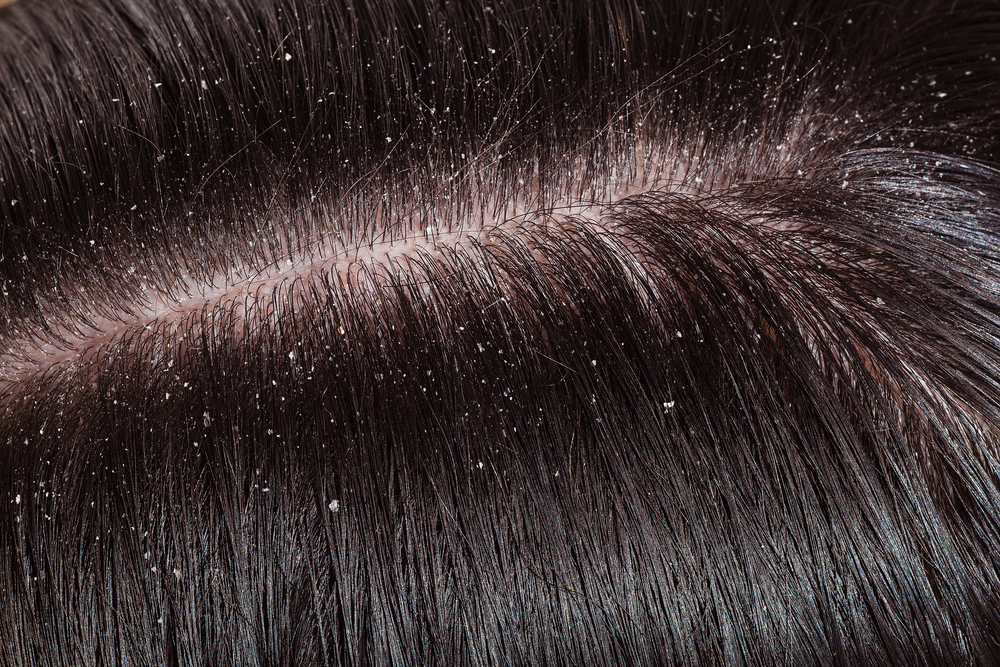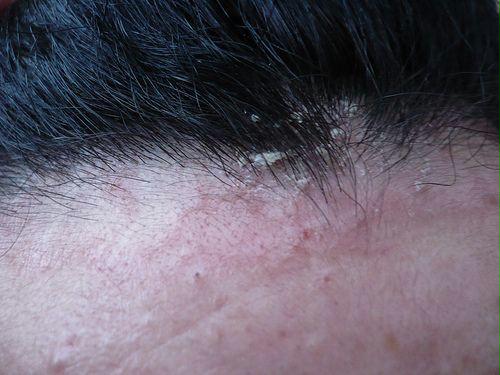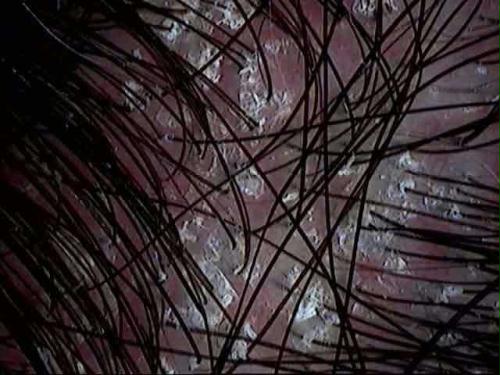alopécia por estresse ou psicogênica
A alopécia psicogênica é um tipo de alopécia relacionada ao estresse: essa conexão, embora ainda não tenha sido explicada cientificamente, é bem conhecida na experiência de quem lida com o problema.

Scientific collaboration between Professor Marco Toscani and Dr. Pasquale Fino, Chair of Plastic, Reconstructive and Aesthetic Surgery, Umberto I Health Center – “Sapienza” University of Rome.
La iperseborrea o ipersecrezione di sebo non è altro che un problema del cuoio capelluto dovuto ad una eccessiva produzione di sebo causata dell’iperattività delle ghiandole sebacee.
Hyperseborrhea or hypersecretion of sebum is simply a scalp problem due to an excessive production of sebum caused by hyperactivity of the sebaceous glands. Immediate symptoms of hyperseborrhea are scalp itchiness and pain. However, a later symptom is hair loss. Skin inflammation associated with hyperproduction of sebum leads to the production of oily flakes on the scalp, on the skin of the ears and inside the ear canal. All of this is also associated with a sensation of pain.
In normal quantities sebum is an oily substance that has the function of protecting the skin from dehydration. It also has antibacterial properties. The presence of excessive sebum results in an alteration of the hydrolipid equilibrium of the skin.


All of this leads to quite serious consequences. You can have simple blemishes, hair loss, acne, comedones or folliculitis. Seborrheic hair loss is characterized by the presence of hyperseborrhea accompanied by hair loss.
The fall and subsequent loss of hair occurs because excess sebum gathers and accumulates in the excretory ducts of the follicles, thereby blocking proper oxygenation of the hair and its normal growth and development.
As a result of hyperseborrhea, hair gets thinner, shorter, duller and weaker with each growth cycle. In fact, its anagen phase becomes shorter and shorter until the follicles die and subsequently hair falls out. It should be remembered that timely intervention is important in order to reduce and eliminate excessive sebum secretion by means of proper treatment capable of avoiding weakness and excessive loss of hair.
It is important to distinguish between normal seborrhea and hyperseborrhea.
The sebaceous glands are secretary organs located near hair follicles. They have the function of secreting sebum. Sebum secretion is a physiological process that starts in adolescence. Sebum forms the hydrolipid barrier which has the function of protecting the scalp and hair from external environmental agents. Moreover, it moisturizes, protects and waterproofs the hair shaft. If sebum secretion remains within certain limits, sebaceous gland activity is considered useful which is why it is called physiological seborrhea.
On the other hand, when sebum production is in excess, normal sebaceous gland function becomes a skin problem, resulting in pathological seborrhea. It makes hair and skin oily. Lifeless skin, a condition that favors the appearance of comedones, occurs when excess sebum is not released and remains in the hair follicles, making skin rough and dry.
When hyperseborrhea is present for brief periods, it must not be considered a pathological condition as this problem may be resolved in a short amount of time. External environmental factors (heat increases vasodilation of scalp capillaries, producing increased blood flow and sebum production), wrong hair treatments (incorrect hygiene practices, treatments that are too aggressive or using the wrong products) or scalp infections may cause temporary hyperseborrhea.
The causes of hyperseborrhea have net yet been clearly defined. Some of the factors that favor the appearance of hyperseborrhea are:
1) hormonal imbalances: it is believed that seborrhea is also influenced by endocrine glands (internal secretion). Therefore, it is thought that hormonal imbalances of the thyroid gland and the pituitary gland could cause hyperseborrhea. Hypersecretion of sebum occurs during puberty in men and during menopause in women.
2) metabolic disorders (nutrition and elimination): a high-fat diet alters the body’s metabolic activity which protects itself by eliminating excess fat thanks to the exocrine glands (the sebaceous glands produce more sebum than normal, resulting in hyperseborrhea).
3) digestive problems (hepatic or intestinal dysfunctions): these alterations change the chemical composition of the sebum produced, making it unusable or inadequate to protect skin and hair.
Our body tries to expel sebum, but since the skin needs fats, the glands continue to produce sebum, thereby creating a vicious cycle that makes it impossible to eliminate excess sebum and consequently to treat the seborrheic skin.
4) nervous factors and stress: when the vagal nervous system gets the better of the sympathetic nervous system it increases blood circulation and sebum secretion which leads to hyperseborrhea.
5) self-intoxication: this occurs when digestive or metabolic disorders alter normal gland secretions, producing toxins that, thanks to sebum and sweat, collect on the scalp, further damaging this area.
Hygiene practices that are too drying, alcoholic hair lotions, abuse of alkaline substances, massages that are too intense and long and vigorous and extended brushing may all lead to excess sebum production.
Among pathogenic microorganisms, demodex folliculorum found in hair follicles is a parasitic larva that changes the chemical composition of sebum, stimulating the glands and resulting in hyperseborrhea.
Seborrhea, especially the pathogenic type, often causes hair to fall out and if not treated properly may compromise hair growth, resulting in seborrheic hair loss. Scalp damage is facilitated by hyperseborrhea. Excess sebum on the skin may favor infections caused by pathogenic microorganisms. Hyperseborrhea may lead to: hair loss, accelerated whitening of hair, oily, greasy hair, greasy, oily and bad-smelling skin, folliculitis, acne or comedones, pityriasis steatoides, seborrheic dermatitis, blemishes or deterioration of the hair.
Sometimes both excess sebum and yellow flakes can be found on the scalp, both of which are symptoms of a single anomaly.
Seborrhea is associated with seborrheic dermatitis. Seborrheic dermatitis has an inflammatory origin. It occurs when the chemical composition of sebum and sweat, also due to pathogens, produces inflammation of the dermis. Seborrheic dermatitis causes oily flakes (dandruff) not only on the scalp, but also in other areas that are rich in sebaceous glands, such as the eyebrows, the skin around the nose, behind the ears and in the armpit and bikini areas.
Intense itchiness on the scalp and the above mentioned areas occurs in individuals affected by seborrheic dermatitis. It may also provoke a painful and annoying sensation on the scalp.
Today topical treatments exist for curing both pathological and occasional seborrhea. In addition to aesthetic reasons, if left untreated or treated incorrectly, seborrhea could lead to a serious loss of hair following the death of hair follicles (seborrheic hair loss). Useful weapons against hyperseborrhea are: antiseptic lotions, lotions with fat-soluble substances (to dissolve fats), lotions with lipid (oil-based) solvents and soothing lotions (amino acids, sulphur, pine tar). Moreover, an astringent action should be applied to sebaceous glands to block them from producing too much sebum and to neutralize the foul odor caused by the superficial oxygenation of lipids (fats) produced by seborrhea.
Therapies with anti-seborrheic and sebum-balancing lotions are very effective when combined with high frequency biostimulation treatments which disinfect the skin and vascularize the follicles, facilitating hair bulb activity. Moreover, laser therapy reinforces hair by stimulating hair follicle activity.
A alopécia psicogênica é um tipo de alopécia relacionada ao estresse: essa conexão, embora ainda não tenha sido explicada cientificamente, é bem conhecida na experiência de quem lida com o problema.
The sebaceous glands are glands that secrete sebum, an oily, acidic substance with a pH of 3.5. They are connected laterally to the hair follicle. Sebaceous glands are found with a density of approximately 100/cm2 throughout all areas of the skin. In the human body, they are located across the entire surface of the skin, except for the palms of the hands and the soles of the feet.
Scalp pain and irritation (or trichodynia) are pathological conditions that affect both women (in a greater percentage) and men (in a lower percentage). The pain felt on the scalp, spontaneous or caused by treatment, and in particular around the roots of the hair, may be more or less intense, alternating at times between periods of disappearance, associated with burning, tingling or itching.
Some parameters and characteristics should be taken into consideration when assessing hair types and morphologies: shape, density and appearance. The appearance of hair, in the form of lanugo, occurs during the fourth month of pregnancy.
The life cycle of hair and its subsequent growth occur at a speed of 1-1.5 cm per month. Hair is a living element that follows a follicle cycle with an average duration of 2-6 years. In humans, unlike other mammals that are subject to a periodic change, this cyclic evolution is not synchronous (therefore each hair is independent from the others).
A alopécia androgenética é o tipo de alopécia mais comum, que atinge a maior parte da população masculina branca, por motivos diversos. É menos frequente em outros grupos étnicos. Muitas vezes apresenta uma familiaridade com a calvície, mas a ausência de outros parentes com a doenção não exclui o diagnóstico. É caracterizada por uma progressiva queda capilar na região do vértice, na marginal frontal anterior e na região temporal.
Nossos especialistas te ajudarão a encontrar o tratamento mais adequado às suas exigências.
Agende uma consulta com nossos especialistas e conheça todos os tratamentos CRLAB.
Nossos especialistas estão prontos para encontrar a solução ideal para você.
NOSSAS SOLUÇÕES CRLAB, especialistas no bem-estar dos cabelos e do couro cabeludo
O método mais eficaz no combate à calvície. Recupera os cabelos de modo espesso e natural, o que permite ao paciente recuperar a sua aparência original. Uma solução patenteada que integra cabelos virgens naturais nas regiões atingidas por falhas de fios e pela calvície: um sistema completamente personalizado que garante funcionalidade e
uma aparência natural.